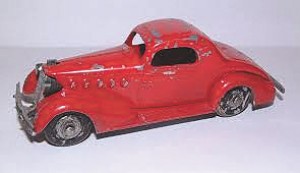We collect for many reasons, but the most motivational of them may well be sentiment.
We love to surround ourselves with things that evoke pleasant memories of the past. For some it may be quilts like great grandmother made, while for others it is the mid-century furniture or posters of the top rock groups of our teens. Nostalgia based collecting takes on many forms, but the top slot belongs to collectible toys and in particular, toy cars.
Toy cars first appeared in the European market in the mid-1890’s. These lightweight cars, stamped from sheets of metal or tin and decorated with paintings and lithography were an instant hit with the public. American toy manufacturers took note of this success and by 1900 several of them were producing cars made of metal, metal alloy, cast iron and stamped steel and lesser grade cars made of pot metal.
Due to the shortage of metal during the war years, production of metal cars ceased in the US. When production resumed, many of the bronze molds used to make toy cars had been for scrap for the war effort. For this reason toy cars are divided into two categories, pre-1940 and those produced after the war, with the older cars being the most valuable.
These little cars can garner big prices at toys shows and specialized auction. But, for the savvy shopper, there are still bargains to be found at estate sales, yard sales and flea markets. As you start your summer junkin’, here are four names to watch for.
Pre-1930’s Buddy “L” cars, 21-24 inches in length. With their size and sturdy steel construction, these cars were large enough for small children to ride on so many of them received heavy wear. Be aware of condition, as it will greatly effect the value. Buddy “L” cars made before 1930 will be marked Buddy “L” Corp. Car; those made after 1930 will be marked Buddy “L” Company.
Tootsietoys, manufactured in Illinois are a common find in the midwest. Production started in 1911, but the company name did not appear on their cars and trucks until 1926 and on some models not until 1931. Identification on the older cars required familiarizing oneself with styles and wheel construction.
Cars from The Arcade Manufacturing Co, Freeport, Illinois are the heaviest cast of and most accurately designed of all early 1900s toy cars. Early examples were marked with a decal, that was replaced by a forged marking in later years.
Hubley toys, highly respected for their complexity and attention to detail, first appeared in 1909. Early toys will be made of cast iron, while those from the mid-1930’s forward will be die-cast zinc alloy.
Post- war cars from 1950-1970 will set you back less money and, as they are seeing an increase in value, can be a good investment. A good general rule for the novice collector is the older the better. Matchbox cars from 1953-1959, referred to as the “1-75 series,” are a good find. These will measure 2.5-3 inches in size, with the model number cast onto the baseplate. Early Hot Wheels from 1968-1976 will have a small red line on the tires. Also watch for the “Hot Wheels Elite” series of Ferraris and the first year castings designed by Harry Bentley Bradley.
The value of antique toy cars is based on three criteria: rarity, desirability and condition. To demand top price cars must have their original box and accessories. Until next time…Linda
Linda Kennett is a professional liquidation consultant specializing in down-sizing for seniors and the liquidation of estates and may be reached at 317-258-7835 or lkennett@indy.rr.com



